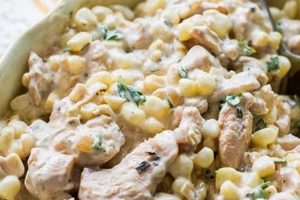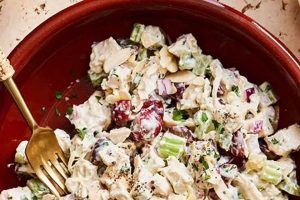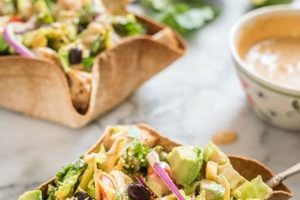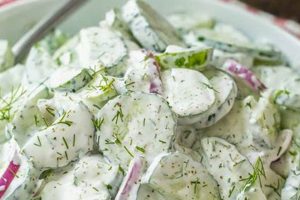This dish typically involves cooked and cooled ramen noodles, often tossed with shredded or diced chicken, a variety of fresh vegetables (such as carrots, cabbage, edamame, or bell peppers), and a flavorful dressing. Variations can include different protein sources (like shrimp or tofu), the addition of nuts and seeds for texture, or the incorporation of fruits like mandarin oranges for a sweeter profile. A simple sesame-ginger dressing or a more complex peanut sauce are common choices for enhancing the flavor profile.
These salads offer a convenient and adaptable meal option. They combine affordability, thanks to the inexpensive base of ramen noodles, with nutritional value from the added vegetables and protein. The versatility of the dish allows for customization to individual preferences and dietary needs. Furthermore, the relative ease of preparation and the ability to prepare components in advance make this a practical choice for busy individuals or meal prepping. This style of salad has gained popularity as a lighter, more refreshing alternative to traditional pasta salads, particularly in warmer months.
The following sections will explore variations on this theme, offering specific ingredient combinations, detailed preparation instructions, and suggestions for customization to create unique and delicious meals.
Tips for Crafting Delicious Ramen Noodle Salads with Chicken
Achieving optimal flavor and texture in a ramen noodle salad with chicken involves careful consideration of several key elements. The following tips offer guidance for creating a satisfying and well-balanced dish.
Tip 1: Noodle Preparation: Avoid overcooking the noodles. Aim for a firm, al dente texture. Rinsing the cooked noodles under cold water stops the cooking process and helps create a desirable texture for the salad.
Tip 2: Chicken Selection: Pre-cooked chicken, whether rotisserie, grilled, or baked, offers convenience. Alternatively, poaching or pan-frying chicken specifically for the salad allows for greater control over seasoning and cooking method.
Tip 3: Vegetable Variety: Incorporate a variety of vegetables to enhance both flavor and nutritional value. Consider shredded carrots, sliced bell peppers, chopped cucumbers, edamame, or shredded red cabbage.
Tip 4: Dressing Enhancement: The dressing is crucial for binding the ingredients and adding depth of flavor. Experiment with sesame-ginger, peanut, or even a simple vinaigrette. Freshly squeezed citrus juice can brighten the flavors.
Tip 5: Texture Considerations: Toasted sesame seeds, chopped peanuts, or crispy chow mein noodles can add a satisfying crunch.
Tip 6: Advance Preparation: Components such as the chicken, vegetables, and dressing can be prepared in advance and stored separately. Combine the ingredients just before serving to maintain optimal freshness and prevent the salad from becoming soggy.
Tip 7: Flavor Balancing: Balance the savory elements of the chicken and dressing with contrasting sweetness or acidity. Mandarin orange segments, dried cranberries, or a splash of rice vinegar can achieve this balance.
By following these guidelines, one can create a delicious and well-balanced ramen noodle salad with chicken that is both satisfying and versatile.
These tips provide a foundation for exploring various recipe combinations and tailoring the dish to individual preferences. The following section will offer concluding thoughts and encourage further culinary experimentation.
1. Noodles (preparation, type)
Noodle selection and preparation significantly influence the final quality of a ramen noodle salad with chicken. While the readily available and inexpensive bricks of instant ramen are a common choice, their preparation requires careful attention. Overcooked noodles result in a mushy texture in the salad, detracting from the overall enjoyment. Cooking the noodles according to package directions, but stopping slightly short of the recommended time, often yields a firmer, more desirable texture. Immediately rinsing the cooked noodles under cold water halts the cooking process and further contributes to a desirable texture. The flavor packet included with instant ramen is typically discarded, as the salad dressing provides ample seasoning. Alternatively, fresh ramen noodles, available in some Asian grocery stores, offer a slightly different texture and flavor profile and can be used to elevate the dish.
Beyond the basic ramen noodle, other noodle types can be substituted. Thin egg noodles, soba noodles, or even rice noodles can create interesting variations. However, the cooking time and method must be adjusted accordingly to ensure the noodles are properly cooked for inclusion in a cold salad. For example, soba noodles, made from buckwheat flour, have a more delicate texture and require less cooking time than traditional wheat-based ramen noodles. Using different noodle types opens opportunities for exploring diverse flavor profiles and textures, allowing for a more customized culinary experience.
Proper noodle preparation forms the foundation of a successful ramen noodle salad. Whether opting for the convenience of instant ramen or exploring alternative noodle varieties, achieving the correct texture is crucial for a pleasant dining experience. The choice of noodle also impacts the overall flavor profile of the salad and offers a pathway for customization. Attention to this seemingly simple component significantly impacts the final result.
2. Chicken (cooked, shredded)
Chicken serves as a primary protein source in ramen noodle salad, contributing significantly to its nutritional value and overall appeal. The preparation and incorporation of chicken influence the final flavor and texture of the dish. Understanding the nuances of chicken selection and preparation enhances the potential of this versatile ingredient.
- Cooking Methods
Various cooking methods yield different results, impacting the chicken’s texture and flavor within the salad. Poaching results in tender, subtly flavored chicken, while grilling imparts a smoky char. Rotisserie chicken offers convenience and a flavorful, readily shredded option. Baking provides a balance of moisture and flavor. The chosen cooking method should complement the overall flavor profile desired for the salad.
- Shredding Techniques
Shredding the chicken, rather than cubing or slicing, allows it to distribute evenly throughout the salad, ensuring each bite incorporates the protein element. Two forks can be used to shred cooked chicken efficiently. Alternatively, a stand mixer fitted with a paddle attachment can quickly shred larger quantities of chicken.
- Seasoning Considerations
Seasoning the chicken during cooking enhances its flavor contribution to the salad. Simple seasonings like salt, pepper, and garlic powder suffice. More complex spice blends or marinades can create distinctive flavor profiles. The choice of seasoning should complement the chosen dressing and other ingredients in the salad.
- Chicken Alternatives
While chicken provides a classic protein base, other protein sources can be substituted for dietary preferences or variety. Tofu, shrimp, or even cooked steak offer compelling alternatives, each contributing a unique flavor and texture to the final dish. The chosen protein should complement the other salad components and the overall flavor profile.
The proper preparation and integration of chicken significantly influence the overall success of a ramen noodle salad. Careful consideration of cooking methods, shredding techniques, and seasoning choices ensures the chicken contributes optimally to the final dish. Exploring alternative protein sources allows for customization and dietary flexibility, demonstrating the versatility of this core ingredient.
3. Vegetables (fresh, variety)
The inclusion of fresh, varied vegetables elevates ramen noodle salad with chicken from a simple dish to a nutritionally balanced and texturally complex meal. Vegetables contribute essential vitamins, minerals, and fiber, while also providing contrasting colors and textures that enhance the overall sensory experience. Strategic vegetable selection is crucial for optimizing both the nutritional value and the aesthetic appeal of the salad.
- Cruciferous Vegetables
Vegetables like shredded cabbage, broccoli florets, or thinly sliced Brussels sprouts contribute a slightly bitter note and satisfying crunch. These vegetables are rich in vitamins and antioxidants. Their robust texture holds up well in the salad, preventing them from becoming soggy.
- Root Vegetables
Shredded carrots, julienned bell peppers, or diced radishes offer sweetness and vibrant color. These vegetables provide a textural contrast to the noodles and chicken. Their inclusion adds visual interest and nutritional diversity.
- Leafy Greens
Baby spinach, shredded romaine lettuce, or chopped cilantro add freshness and a lighter texture. These greens contribute vitamins and minerals while also adding a refreshing element to the salad. However, delicate greens should be added just before serving to prevent wilting.
- Other Vegetables
Ingredients such as chopped cucumbers, edamame, bean sprouts, or sliced snap peas offer unique flavors and textures. These additions further diversify the nutritional profile and provide interesting textural elements. Consider blanching certain vegetables, like snap peas, to enhance their color and retain their crispness.
The strategic incorporation of various fresh vegetables transforms ramen noodle salad with chicken into a complete and satisfying meal. The interplay of textures, colors, and flavors created by the diverse vegetable components elevates the dish beyond its simple origins. Thoughtful vegetable selection ensures a nutritionally balanced and visually appealing salad that caters to a range of palates and dietary preferences.
4. Dressing (flavorful, balanced)
The dressing serves as the unifying element in ramen noodle salad with chicken recipes, binding the individual components and imbuing the dish with a cohesive flavor profile. A well-crafted dressing elevates the salad beyond a simple assembly of ingredients, transforming it into a harmonious and satisfying culinary experience. The balance of flavors within the dressingsweet, sour, salty, and savoryis crucial for achieving a well-rounded and enjoyable result.
- Flavor Profiles
The chosen dressing should complement the other ingredients in the salad, creating a balanced and harmonious flavor profile. Classic options include sesame-ginger, peanut, or a vibrant citrus vinaigrette. Each dressing offers a distinct character; sesame-ginger provides a nutty, savory depth, while peanut sauce lends a creamy richness. A citrus vinaigrette introduces a bright, acidic counterpoint to the other ingredients. The specific flavor profile should be selected based on the desired overall taste of the salad.
- Balancing Elements
A successful dressing balances key flavor elements: sweetness, sourness, saltiness, and umami. Sweetness can be derived from ingredients like honey, maple syrup, or fruit juice. Sourness often comes from vinegar or citrus. Salt enhances the other flavors, while umami can be achieved through ingredients like soy sauce, fish sauce, or miso paste. The interplay of these elements creates a complex and satisfying flavor profile.
- Texture and Consistency
The texture and consistency of the dressing also play a vital role. A creamy dressing, like peanut sauce, clings to the noodles and other ingredients, ensuring a flavorful coating. A thinner vinaigrette offers a lighter, more refreshing counterpoint. The desired texture influences the choice of ingredients and the overall mouthfeel of the salad.
- Homemade vs. Store-Bought
While store-bought dressings offer convenience, homemade dressings provide greater control over ingredients and flavor profiles. Homemade dressings allow for customization and the use of fresh, high-quality ingredients. This flexibility empowers culinary creativity and allows for adjustments to suit individual preferences.
The dressing is arguably the most critical component of a successful ramen noodle salad with chicken recipe. It is the element that transforms individual ingredients into a unified and flavorful dish. Careful consideration of flavor profiles, balancing elements, texture, and the choice between homemade and store-bought options allows for the creation of a salad that is both delicious and satisfying. The dressing is the conductor of the culinary orchestra, bringing all the elements together in harmony.
5. Toppings (optional, crunchy)
Toppings offer an opportunity to enhance the textural complexity and visual appeal of ramen noodle salad with chicken. While optional, crunchy toppings introduce a contrasting element to the softer textures of the noodles, chicken, and vegetables. This contrast elevates the sensory experience of consuming the salad, adding a satisfying dimension beyond the primary flavors. Consider the interplay between toasted sesame seeds and the softer noodles, or the crunch of chopped peanuts against the tender chicken. These textural juxtapositions create a more dynamic and engaging culinary experience.
Specific topping choices can also contribute nuanced flavors that complement or contrast with the existing flavor profile of the salad. For example, crispy fried onions add a savory depth, while toasted slivered almonds introduce a subtle nuttiness. The addition of chopped cilantro or green onions provides a fresh, herbaceous element. Even a simple sprinkle of black sesame seeds can enhance the visual appeal and provide a mild nutty flavor. Careful selection of toppings allows for customization and the creation of unique flavor combinations tailored to individual preferences. Consider a spicy peanut dressing paired with chopped peanuts and cilantro for a cohesive flavor profile, or a sesame-ginger dressing complemented by toasted sesame seeds and crispy chow mein noodles for added crunch.
Thoughtful incorporation of crunchy toppings elevates ramen noodle salad with chicken from a simple dish to a more sophisticated and satisfying meal. The interplay of textures and complementary flavors enhances the sensory experience, while the visual appeal adds to the overall enjoyment. Strategic topping selection allows for personalization and culinary creativity, transforming a basic salad into a customized culinary creation.
6. Preparation (method, timing)
Preparation method and timing significantly influence the final quality and enjoyment of ramen noodle salad with chicken. Careful consideration of these factors prevents a soggy, unappetizing outcome and ensures a fresh, flavorful, and texturally satisfying salad. The sequence of steps and the timing of ingredient incorporation directly impact the final product.
For instance, preparing components in advance, such as cooking and shredding the chicken, making the dressing, and chopping the vegetables, streamlines the final assembly process. Storing these components separately until just before serving prevents the noodles from absorbing excess moisture from the dressing and vegetables, preserving their desirable texture. Conversely, adding the dressing too early results in soggy noodles and a less appealing salad. Similarly, incorporating delicate leafy greens too far in advance can lead to wilting and a loss of freshness.
Timing also plays a crucial role in achieving optimal flavor development. Allowing the flavors of the dressing to meld by preparing it in advance enhances its overall impact. Marinating the chicken before cooking can infuse it with deeper flavor. Understanding the importance of timing and employing strategic preparation methods ensures a delicious and well-balanced ramen noodle salad with chicken. Attention to these details elevates the dish from a simple assembly of ingredients to a carefully orchestrated culinary experience.
Frequently Asked Questions
This section addresses common inquiries regarding ramen noodle salad with chicken, offering concise and informative responses to clarify potential uncertainties and enhance understanding of this versatile dish.
Question 1: Can the flavor packet included with instant ramen be used in the salad dressing?
While the flavor packet can technically be used, it often contains a high concentration of sodium and artificial flavorings. A homemade dressing or a store-bought alternative generally offers a more balanced and flavorful outcome.
Question 2: What can be substituted for chicken in this salad?
Alternative protein sources such as shrimp, tofu, cooked steak, or even chickpeas can be substituted for chicken, catering to various dietary preferences and flavor profiles.
Question 3: How long can the prepared salad be stored in the refrigerator?
For optimal quality, it is recommended to consume the salad within two days of preparation. Storing the noodles, chicken, vegetables, and dressing separately until just before serving helps maintain freshness and prevents the salad from becoming soggy.
Question 4: What types of noodles can be used besides instant ramen?
Alternative noodle choices include fresh ramen noodles, thin egg noodles, soba noodles, or even rice noodles. Adjust cooking times accordingly to ensure proper texture.
Question 5: How can the nutritional value of the salad be maximized?
Incorporating a variety of colorful vegetables, such as bell peppers, carrots, edamame, and leafy greens, increases the vitamin, mineral, and fiber content of the salad.
Question 6: Can the salad be made ahead of time for a potluck or picnic?
Yes, but it is advisable to keep the componentsnoodles, chicken, vegetables, and dressingseparate until just before serving to prevent the salad from becoming soggy. Transport the ingredients in separate containers and combine them on-site.
Understanding these common points of inquiry allows for greater confidence and flexibility in preparing and enjoying ramen noodle salad with chicken. These insights empower individuals to tailor the dish to their specific preferences and dietary needs.
This concludes the frequently asked questions section. The following section will offer a summary and concluding thoughts.
Conclusion
Exploration of ramen noodle salad with chicken recipes reveals a dish offering adaptability, nutritional value, and convenience. Careful consideration of noodle preparation, protein choices, vegetable variety, dressing selection, and optional toppings allows for extensive customization. Emphasis on proper timing and component preparation ensures optimal texture and flavor, preventing a common pitfall of sogginess. Understanding these elements empowers creation of a balanced and satisfying meal.
This adaptable dish offers a canvas for culinary creativity, encouraging exploration of flavor profiles and ingredient combinations. Potential for customization caters to diverse dietary needs and preferences. Ramen noodle salad with chicken recipes stand as a testament to the versatility of simple ingredients, transforming readily available components into a delightful and nourishing culinary experience. Continued exploration of variations and flavor combinations promises further culinary discoveries within this adaptable framework.






